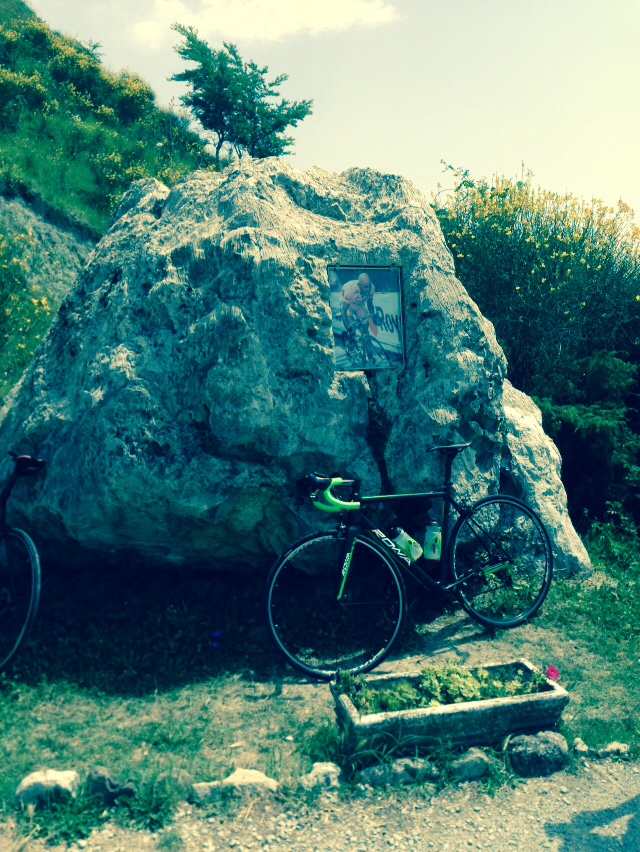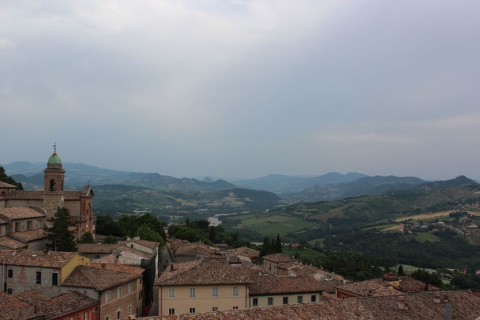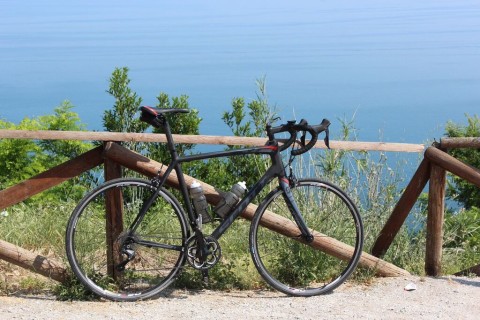Pantani’s playground: Riding in Italy’s Emilia-Romagna region
Emilia-Romagna has dubbed itself “the land of cycling.” Its coastline seems to go on forever. The roads are silky smooth with banked switchback turns on the rolling coastal and inland hills.

by Joel Vosburg
To start the gallery, click an image and use your keyboard’s arrow keys to navigate. For image information within the gallery, click the ‘i’ icon.
This past June, I had the opportunity to ride In Marco Pantani’s playground. Emilia-Romagna, the region in northern Italy, features the city in which the winner of the Tour de France and the Giro d’Italia was born (Cesena) and the city where he died tragically in 2004 (Rimini). The area also has the road and climbs on which Pantani honed his abilities as a rider.
Today, Emilia-Romagna has dubbed itself “the land of cycling.” Its coastline seems to go on forever. It has silky smooth roads with banked switchback turns on the rolling coastal and inland hills. There are vineyards and olive groves. The restaurants feature fresh seafood. It has hotels that cater to riders looking to test their legs on the bike and get the most out of their time off of it.
My cycling trip started at the Dory Bike Hotel in Riccione. The hotel has a “three bike” rating (the highest) from Terrabici, the area’s cycling hotel conglomerate and is on the top of its list for bike hotels in the area. The hotel sits steps away from the Adriatic Sea and only a few kilometres from the rolling hills of region’s interior. Dory Hotel has all the amenities you could need during your stay. There is a massage and wellness clinic, an onsite mechanic who has worked on bikes for more than 40 years, cycling guides, secure bike storage and a support van during your rides full of the necessary supplies. The food, coffee and wine is also top notch.

[space height=”12″]
On my trip, the first day of riding was sunny and fresh air came off the sea as my group got ready to ride. The Dory supplied us with bikes for the week; I was fitted to a Scott CR1, a lightweight and race-ready machine. This bike held the title for lightest production bike at the time of its launch.
The roads of Riccione took us into the countryside and the local hills. The plan was to ride through the rolling hills and finish our first half of the ride at the top of San Marino, roughly 25 km away. The riding through the countryside was something special. While you try to focus on the wheel in front of you, your eyes are tempted by spectacular views all around. The hills are dotted with colourful farms of grapes and grains. As spectacular the sights were, San Marino itself stole the show. San Marino is a beautiful small republic built into the side of a rock cliff overlooking the valleys of olive groves and farmland below. The micro-state is known to the locals as a tax haven, with only 13 per cent of income being taxed compared with the more than 30 per cent the rest of Italy has become accustom to. During our San Marino ascent, our guide told us to be on the lookout for any potential soul mates as marriage is the only way to become a citizen for the republic. As we climbed through the city streets, our legs in pain, the business owners, locals, and tourists cheered us on. Multiple times up the climb, people held out their arms for quick high-fives. I imagined it was a small taste of what Tour riders must experience on l’Alpe d’Huez. (I, however, returned high-fives.) It was a unique experience for me. But according to the guides, that was just another day in Emilia-Romagna.
Back at the Dory, the bikes were put into the secure lockers. The onsite mechanic made some small tune-ups for the next day’s ride. Inside the hotel, as I walked through the the lobby sweaty, Lycra-clad with my cleats clacking, I had another unique experience: almost no one batted an eye. Cyclists are the norm in this hotel; my look was simply an everyday occurrence.
That evening, it was onto the highlight that every cyclist and non-cyclist talks about on a trip to Italy, the food. The post-ride meals in Emilia-Romagna were always special and seemed to have around 10 courses. Wine, local cheeses, meats were always starters to a late-night meal, and then salads, fresh pastas, seafood, more meats and desserts, and some more local wine. Even after all the calories burned from a full day of riding, it can be tough coming out of each meal feeling like you are not going to gain weight.
Pantani’s playground
Looking to have your legs burn from a pretty serious climb? Head to Montevecchio. (Good luck beating the KOM records.) This famous climb was Il Pirata’s favourite incline. There are monuments throughout Emilia-Romagna, and even a museum, in Marco Pantani’s honour. But if you want to get a true feel for who Pantani was as a rider head to Montevecchio. Pantani is famous for the way he used to pull away from the world’s top riders on the steepest parts of climbs with little effort. He had used Montevecchio to hone his craft by doing repeats up this 4.28-km climb that boasts an average grade of seven per cent with 20 per cent grades that require bursts of effort around the switchback turns. There are stories of Pantani putting on a dress and a wig, grabbing his old fixed-gear bike and heading up the climb, passing cyclists working with all their might as the cross-dressing rider seemed to exert little effort.

[space height=”12″]
You can see Pantani’s name painted on the black asphalt throughout the entire climb. When you get to the top, you’re greeted by a Marco Pantani monument: a picture of Pantani is carved into the rock face of a boulder beside the finish. Take some pictures and then descend down the backside of the hill back toward the flats and your hotel.
Nove Colli gran fondo
Nove colli is Italian for “nine hills,” which feature in the Nove Colli gran fondo. The fondo is one of Italy’s most famous and popular cycling events. With more than 9,000 riders signing up within the first four minutes of registration and another 3,000 sold with hotel packages, the Nove Colli always sells out. The ride climbs through Emilia-Romagna interior region covering the area’s rolling hills and valleys. There is no single climb in this event that will take everything out of you; it is the barrage of smaller climbs combined with the 200 km distance that is sure to wear even the most experienced riders down. There is also the option for a 130 km ride that includes the first four hills if the full distance isn’t your thing. If you are a fan of gran fondo riding, be sure to have fast fingers at registration opening or stay at one of the select hotels in Terrabici that offer entries to the fondo with your stay.

[space height=”12″]
Overall riding experience
Emilia-Romagna feels like it grew up riding, everything in the area is geared toward cyclists. The region many not have the long, brutally hard Giro climbs of the Dolomites to the north. Still, the climbs you will encounter in Emilia-Romagna will be short, steep and sure to take the energy out of your legs by the time you get to the top. Once you are back onto the flat surfaces, you will be wishing you had more time before the next hill. The seaside hill views that can be seen from the coastal roads of the Adriatic Sea are views that rival any vistas in the country. The drivers in this area have the utmost respect for cyclists. Never during our four days of riding did we have a car come too close, honk its horn or cut us off—a nice change from the more car-centric Anglo/North American/Australian roads we are used to. The roads are generally in great condition, which was very noticeable on the descents where braking was usually optional. Switchbacks almost felt like they were banked allowing for controlled and fast descents. We were quick to notice the convex mirrors placed on switchback turns, which help when picking your line around a corner and not going head on into an approaching vehicle. The mirrors are nice safety touches that help you keep more of your speed through the turns.

[space height=”12″]
What to do
- Get out of the hotel and onto your saddle ready to ride. The area boasts some of the most picturesque countryside in Italy. There are plenty of rolling hills with lower grades (three to seven per cent) waiting just outside the coastal city of Cesenatico. Make sure to stop riding every once in a while to take in the vineyards and olive groves.
- The area is known for its wine. More than 136,000 acres were under vine in the region as of 2010. Plans to expand this acreage is always in the works. Have your guide set out some strategic stops along your ride to do some small tastings of wine, prosciutto and piadina. Be carefull when the local grappa makes an appearance; you will still have to ride back to your hotel.
- Visit the Marco Pantani Museum in Cesenatico where you will find the cyclist’s bikes, trophies, artwork of Pantani as well as some unique artwork painted by the man himself. I recommend his shark painting.
Where to stay
Cyclists can’t stay at any old hotel: they need a place that understands the importance of a bicycle. Emilia-Romagna has worked together with the region’s hotels to put together a consortium called Terrabici that specialize in catering to your specific needs. A rating system of one bike, two bikes or three bikes classify each hotel based on its level of service for cyclists. One-bike hotels will have bike storage, massage therapists and onsite mechanics that can tune up or build your bikes. Three-bike hotels have all the amenities of a one- and two-bike hotel, but will have further amenities, such as daily guides for hire (recommended), support vehicles and top-end bike rentals.
Terrabici offers a free consultation to match your needs and help you find the right hotel for your cycling holiday.
What to eat
- An area famous for its fresh pastas and meats, Emilia-Romagna was the birthplace for some of the world’s most popular delicacies: prosciutto, Parmesan cheese, mortadella sausage all originate in this region.
- If you are a seafood fan, head for the coast. Along the Adriatic, there are many restaurants specializing in food fresh from the sea. You can watch fishing boats depart nightly at 10:00 p.m. to catch the next day’s dinner. Plates lined with mussels, scallops and squid will be some of the freshest and best-tasting seafood that will help you recover from the rolling hills you conquered earlier that day.
- Parmesan cheese from Emilia-Romagna, Parmigiano-Reggiano, is the real deal. Only cheese produced here can legally be called Parmigiano-Reggiano.
How to get there
Flights from all the major hubs in Europe will have flights going into Bologna in the heart of Emilia-Romagna. From the Bologna airport, it is a 45-minute drive via hotel busses to the coast where the real riding begins.

[space height=”12″]
























